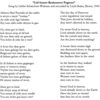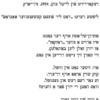7: Song, untitled pogrom lament, c. 1903.
Here we have another song in Yiddish about the pogrom in Kishinev. The song would later be rewritten in response to far larger and even worse waves of pogroms in Russia and Eastern Europe that followed in 1905–1906 and again between 1915 and 1920. The revival of the song in response to new episodes of violence suggests that the Kishinev experience and its commemoration in some sense set the template for understanding pogroms in the popular Jewish imagination.
In this recording, taken in the Bronx in 1954, the song is sung by Lifshe Schaechter-Widman.
Suggested Activity: Compare the Bialik poem to the tradition of pogrom-laments that took shape in the Yiddish popular culture that flourished on both sides of the Atlantic. What images do you see in the song? How do these images compare to the ones Bialik highlighted in his work? How does the melody inform your understanding of the piece?
Imagine setting part of “In the City of Slaughter” to music. What sort of melody or accompaniment do you imagine would help an audience to understand the poem?
Source: Itzik Gottesman, “One Song – Three Pogroms,” The Yiddish Song of the Week, accessed online, September 12, 2019.
18_Der_keshenever_pogrom.mp3
 Download audio (2.49 MB)
Download audio (2.49 MB) Lid funem Keshenever Pogrom
 Download image (136.34 KB)
Download image (136.34 KB) Keshenever Yiddish
 Download image (46.07 KB)
Download image (46.07 KB) Keshenever Yiddish 2
 Download image (30.23 KB)
Download image (30.23 KB)



